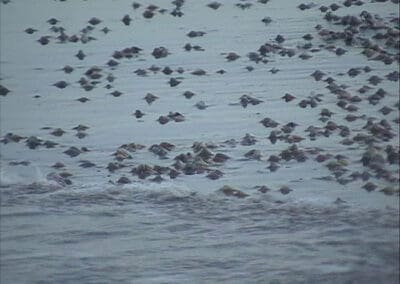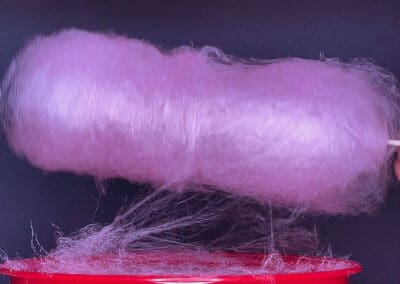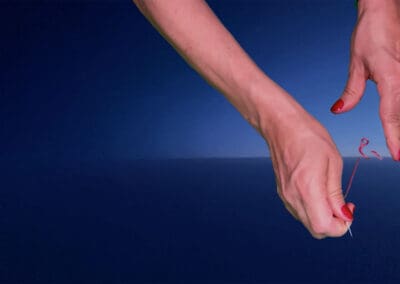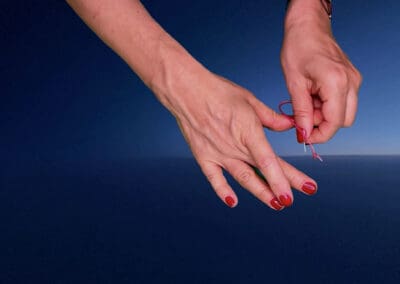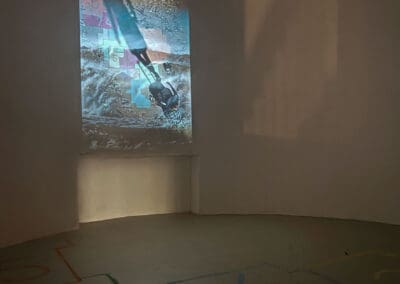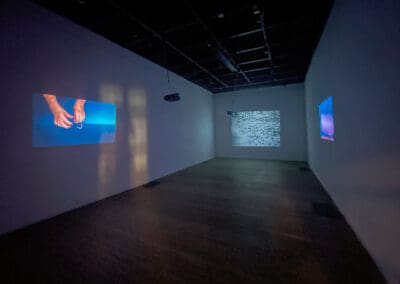Himmel und Hölle kiállítás
Himmel und Hölle
Gőbölyös Luca kiállítása
Fészek Galéria Budapest 2022.06.28-07.24
Himmel und Hölle, 2017, videó (17 perc 20 mp), Herman terem
Ebben a munkámban Európa néygyzethálóssá absztrahált térképén nehézségek árán átugrabugráló figurámmal a helykeresést, az otthontalanságot, a folyamatos újrakezdéstszimbolizálom a menekültválságra reflektálva. Amikor a videó készült, idegenként éltem Németországban.
A menekültek a világ válsággócaiból olyan országok felé tartanak, amelyektől biztonságot remélnek. Az ugróiskola az egyik legelterjedtebb játék a világon: földbe karcolt, krétával vagy puha kővel aszfaltra rajzolt ábrái mind az öt világrészen megtalálhatók. Németül Himmel und Hölle, vagyis mennyország és pokol az elnevezése, ami a játék eredetére utal: egy utat kell bejárni, miközben különféle akadályokon át a földről (jó vagy rossz) a túlvilágig jutunk. A játékosnak van egy kavicsa, vagy cserépdarabja, ezt az első mezőbe dobja, fél lábon utánaugrik, lehajol érte, átdobja a következő mezőbe és maga is utána ugrik fél lábon maradva, s így folytatódik ez tovább. Hibázik a játékos, ha a követ vonalra, vagy nem a megfelelő mezőre dobja, illetve, ha nem pontosan a kívánt mezőbe ugrik, vagy leteszi a lábát. Így ezt a menetet elvesztette, és játszótársa következik, vagy a szigorúbb szabályok szerint vissza kell mennie a startmezőre.
Azért választottam ezt a játékot, mert az életutat szimbolizálja, akadályokon keresztül kell eljutni a célba, vagyis a vélt vagy valós mennyországba. Az én ugróiskolám eltér az eredeti ábrától, annál bonyolultabb, de használja annak alapvető elemeit: a földet, a poklot, és a mennyországot. Az ugrótába megalkotásakor Európa olyan térképét használtam, amely egy négyzethálós rendszerben mutatja az országokat a lakosságszám szerint. Ezt a térképet szűkítettem le a Magyarországot érintő főbb menekült útvonalak országaira, és számoztam be ezek szerint. Az általam létrehozott ugróiskolában alternatív útvonalak vannak, amin végighaladva el lehet jutni a mennyországba, a célországba, Németországba.
Kiindulópontnak a partot érés helyeit, Törökországot és Görögországot tettem egyes számú mezőnek, ami eredetileg a földet szimbolizálja. Ahogy áthaladunk a számozott mezőkön, elérjük a “poklot”, Magyarországot, amit X-szel jelöltem, ahogyan a hagyományos ábrán is.
Jelen esetben, tekintve, hogy Magyarország nem fogadott be közel-keleti és afrikai menekülteket, ez az a mező, amit át kell ugrani, ha a játékos nem akar kiesni.
A filmen egyetlen játékos próbálja teljesíteni a szinte lehetetlen feladatot: én magma; magassarkú cipőben és rövid szoknyában, azt jelezve, hogy mindenki lehet menekült. Én ugrálok végig féllábon, magassarkú cipőben, kavicsot dobva mindig a következő mezőbe, aztán utána ugorva, hogy eljussak Németországba, ahol végre letehetem mindkét lábam.
Amikor elrontom, a film visszatekeredik, és én kezdhetem elölről az ugrálást. Sokszor elrontom, elég nehéz a feladat, küzdelmes “végighaladni Európán”. Amikor célba érek, átlátszóvá válok, felszívódok, és az egész küzdelem kezdődik előlről. Akárhányszor elindulok, behúzom a képbe a bőröndömet, amit azonban kénytelen vagyok otthagyni a startnál, mivel nem tudok vele együtt haladni. Az árnyékom (átvitt értelemben a menekültek “réme”) rávetül Európára, és az “utam” során megelőz engem.
A video hangja a 4 éves kislányom által elmondott gyerekvers ismétlődése: “1 2 3 4 te kisleány hová mégy? Nem megyek én messzire, csak a világ végire, ott sem leszünk sokáig 1 2 3 óráig!”
Human behavior, 2007, videó (4 perc)
A természet erőivel együtt vagy azok ellenében való élni akarás metafórájaként hoztam létre ezt a loopolt videófilmet. Amikor a tenger hullámai visszahúzódnak egy-egy rövid pillanatra, megjelenik az élet, amit a következő pillanatban újra elönt a víz. Hiába tudott a hullámzás ritmikussága, arra a rövididőre amíg az visszahúzódik, az élet zsibongásával telik meg a levegő, újra és újra.
Over The Rainbow, 2022, videó (4perc 16 mp)
A jelen neokonzervatív, hagyományos értékeket valló patriarchális társadalmaiban a nőt, aki erőszak tárgya, megbélyegzi és kiveti magából a közösség, illetve az áldozatot okolja. A videóban a szexuális zaklatással foglalkozom női szempontból; hogyan távolítjuk el magunktól az elvárások narratívájába nem ízülő történteket, mire emlékszünk, s mi marad bennünk egy-egy erőszakos esemény után. Miért érezzük magunkat hibásnak, koszosnak olyankor, amikor elszenvedői, áldozatai vagyunk egy molesztáló vagy erőszakos szituációnak. Miért fedjük el, s miért, hogyan tesszük láthatatlanná ezeket a sérüléseinket? Videómunkám az emberi integritás törékenységét idézi meg, a láthatatlan, elfedődött, de a mélyben megmaradt sérüléseket.
Void Traces of Existence, 2022, videó (7perc 30 mp)
A képről, a valóság leképezéséről, annak megváltoztatására irányuló hiábavaló, de sziszifuszi tevékenységeinkről gondolkodom ebben a munkámban. Megpróbálom a lehetetlent: összevarrni a földet az éggel, mennyet a pokollal, rendet teremteni, eljutni valahova, megérkezni a turbulencia ellenére, éppúgy, ahogyan a kiállítás címadó munkájában is.
Gőbölyös Luca
Heaven and hell exhibition
Heaven and hell exhibition
Luca Gőbölyös exhibition
Fészek Gallery Budapest 2022.06.28-07.24
Himmel und Hölle, 2017, video (17 min 20 sec), Herman Hall
In this work, I have created a map of Europe, abstracted into a rectangular grid, at the cost of difficulties with my figure leaping across the map of Europe with difficulty, I symbolize the search for a place, the homelessness, the constant rebuilding reflecting on the refugee crisis.. When I made the video, I was living as a stranger Germany as a foreigner.
Refugees from crisis zones around the world are heading to countries that offer them safety and security. they hope for.
The jumping school is one of the most popular games in the world: scratched into the ground with chalk or soft stones drawn on asphalt in all five continents. In German, Himmel und Hölle, or “Himmel und Hölle”. Heaven and Hell, which refers to the origin of the game: a path to travel, a path through various obstacles from earth (good or bad) to the afterlife. The player has to has a pebble or piece of clay, throws it into the first square, jumps after it on one foot, bends down throws it into the next field and then jumps after it, staying on one foot, and so on it goes on. The player makes a mistake if he throws the stone on the line or to the wrong field, or, if he does not jump exactly into the desired field or if he puts his foot down. So this round is lost, and is followed by his opponent, or he must go back to the starting field according to the stricter rules.
I chose this game because it symbolizes the journey of life, you have to go through obstacles and back to the start line. to get to the finish line, which is the imaginary or real heaven. My skipping school is different from the original the more complicated it is, but it uses the basic elements of the original figure: the earth, hell, and the heaven. In creating the jumping off point, I used a map of Europe that is a a grid system showing countries by population. I used this map I narrowed it down to the countries on the main refugee routes through Hungary, and counted according to these numbers. In the jumping school I created, I have alternative routes that to get to heaven, the destination country, Germany.
As a starting point, I have made the landing places Turkey and Greece the number one which originally symbolized the land. As we pass through the numbered fields, we arrive at “hell”, Hungary, which I have marked with an X, as in the traditional diagram.
In this case, given that Hungary has not accepted Middle Eastern and African refugees, this is the field that must be jumped over if the player is not to be eliminated.
In the film, there is only one player attempting to complete the almost impossible task: myself; wearing high heels and a short skirt, indicating that anyone can be a refugee. Me bouncing along on one foot, wearing high heels, throwing pebbles into the next box, then leaping after it to get to Germany, where I can finally put both feet down.
When I mess up, the film rewinds and I can start jumping all over again. Many times I mess up a lot, it’s quite a difficult task, it’s a struggle to “run across Europe”. When I reach the finish line, I become transparent, I disappear and the whole struggle starts all over again. Every time I start, I pull my suitcase into the picture, but I have to leave it at the start because I can’t go with it. My shadow (metaphorically the “terror” of the refugees) is cast over Europe and overtakes me on my “journey”.
The sound of the video is a repetition of a nursery rhyme recited by my 4-year-old daughter:
‘1 2 3 4 you little girl where are you going?
I’m not going far,
I’m going to the end of the world,
We won’t be there for long 1 2 3 hours!”
Human behavior, 2007, video (4 min)
I have used it as a metaphor for the will to live with or against the forces of nature I created this looped video. When the waves of the sea recede for a brief moment moments, life appears, and the next moment it is flooded again. In vain could the the rhythmicity of the waves, for the brief moment they recede, life’s roar is there. the air, again and again.
Over The Rainbow, 2022, video (4min 16 sec)
In today’s neo-conservative, patriarchal societies with traditional values, women, who is the object of violence is stigmatised and cast out by the community and blamed on the victim. A video, I deal with sexual abuse from a woman’s perspective; how to remove the narrative of expectations, what we remember and what remains we remember after a violent event. Why we feel blamed, dirty when we are the victim of an abusive or violent situation. Why do we cover up and why and how do we make these injuries invisible? My video work evokes the fragility of human integrity, the invisible, the covered up, but the wounds that remain in the depths.
Void Traces of Existence, 2022, video (7min 30 sec)
About the image, about the representation of reality, about the futile but futile attempt to change it but dissipated activities in this work. I am trying to make the impossible: to sew earth to sky, heaven to hell, to create order, to reach to get somewhere, to arrive in the face of turbulence, just as the exhibition’s title in the title work of the exhibition.
Luca Gőbölyös

